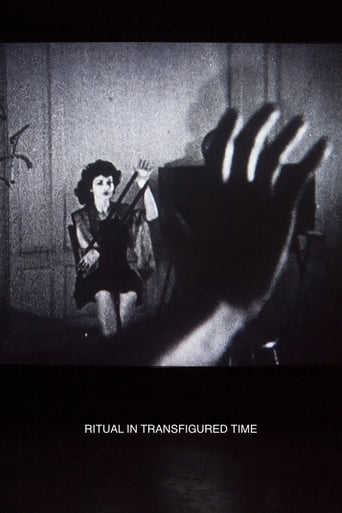



Truly Dreadful Film
One of my all time favorites.
A brilliant film that helped define a genre
Ok... Let's be honest. It cannot be the best movie but is quite enjoyable. The movie has the potential to develop a great plot for future movies
View MoreMaya Deren was a pioneer: at a time when the Hollywood studio system was at its peak pumping out crowd-pleasing genre movies with huge budgets, Ukrainian born Deren was carving out a position for herself as a self-financed avant-garde female director and (under-rated) film theorist whose films explored the role of women in society through non-narrative cinema which also explored the potential of dance on film. And as such, "Ritual in Transfigured Time" seems to balance both of these strands of her work (compared to the crushing feminist existentialism of her debut "Meshes of the Afternoon" (1943) and her totally abstract dance-dominated later films like "The Very Eye of Night" (1958)) and stand as possibly the greatest encapsulation of the themes that motivated her.The film is essentially in three parts in the classic set-up / conflict / resolution style but the transitions between each "act" is characterized by a dream-like spatial shift: at first from a room where a young dancer (Rita Christiani) helps Maya manically roll a ball of wool, before being led by another woman (played by prolific diarist and Henry Miller's squeeze, Anaïs Nin) to a crowded cocktail party. Whilst here, the young woman navigates through the gathered party-goers whose movements in and out of conversations become increasingly stylized and choreographed until they are essentially dancing. Finally, the young dancer meets a young man and the scene switches to outside where the young man pursues the woman in a manner both elegant and threatening.As with earlier Deren's films "Meshes of the Afternoon" and "At Land" (1946), the film seems to have something to say (in this case about the various social rituals, sometimes so choreographed as to be a "dance", which we are forced to perform) and does actually convey this through a plot albeit a dream-logic one. However, like a poet, Deren also articulates her message through the choices she makes in regard to the form of the film – in this case the unusual spatial cuts and use of effects like freeze-framing and negative prints – which, rather than distract us from the story (as in a "traditional" film), makes us question the relation between the events happening on screen as well as our relationship to it, with the effect that we are pulled further and further into Deren's unique vision.
View MoreMaya Deren has sometimes been called a proto-feminist due to the topics she explores in many of her films, including her famous "Meshes of the Afternoon" and the lesser known but still stunning "At Land". This film would be the one that comes closest to feminist concepts. Women in this short are trapped in "rituals" of subservience, marriage, and victimization, often being passed around, chased, or ogled by the men in their various aspects.If Deren's work is about dreams, this is probably the one that comes closest to an anxiety dream. The party scene (which I feel is slightly clichéd, but then again Deren may very well have been the one to have created these clichés) is claustrophobic, the chase is paranoiac, and many of the clothes the women wear are iconoclastic (nun-suit, any one?).My favorite scene involves the man who dance-leaps after the woman as she moves through Greek architecture. Deren captures the motion of the dancer in freeze-frame always in moments where he is balanced so as to look exactly like a Helenistic sculpture. It's another one of those Derenist moments that has an uncanny relevance even to those who aren't familiar with Deren's own personality.--PolarisDiB
View MoreRitual in Transfigured Time may be the piece in which Maya Deren puts all her interests and achievements: a surrealistic narrative and dance choreographies. It is beautiful and powerful, but may have too many elements to be coherent and to possess her earlier works' strength.
View MoreRitual in Transfigured Time is like a dream, meaning that the various sequences don't seem to have any connection to each other unless you try to approach this film in a different way and not as a conventional hollywood movie.The main character in the film is Rita Christiani who after a strange scene with Maya Deren herself who disappears startling Rita, appears in this ball with ladies and gentlemen dancing. This film has one of the most beautiful scenes in a Maya Deren's film when Rita Christiani while she's dancing she appears to float in the air.Unlike most films that were made 50 or more years ago Ritual in Transfigured Time appears to be timeless and a lot of directors who try to do something innovative should get a lesson or 2 from Maya Deren.I was very surprised to find out that the famous writer Anais Nin is in this movie as well (I was also very pleasantly surprised when I found out that avant garde composer John Cage was in another film by Maya Deren, "At Dark").
View More